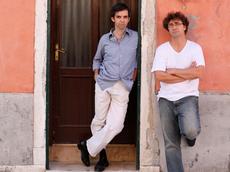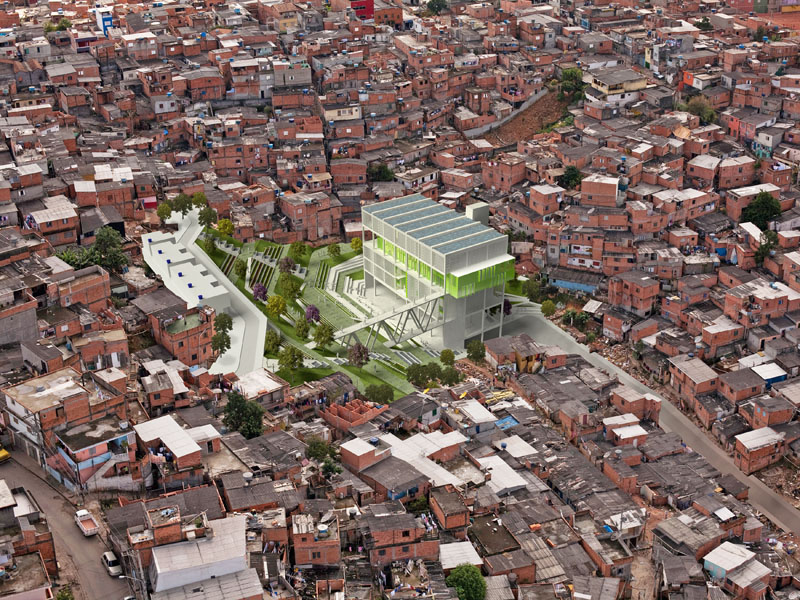The Monte Rosa hut in a favela
ETH Zurich professors Alfredo Brillembourg and Hubert Klumpner received another international prize for the community centre project in São Paulo’s largest favela. What is it that drives these restless architects and urban planners through the world’s slums?

Professor
Brillembourg, Professor Klumpner, architects from ETH Zurich are normally
renowned for their prestige buildings in wealthy areas, but you create your
works in the ghettos where the less privileged people live. Is it also
possible to get famous that way?
Klumpner: It is true that discussions surrounding architecture
in centuries past focused primarily on buildings for the elite by the elite.
Scarcely any architectural records have been preserved of buildings for the
ordinary people. However, in the past decade social responsibility in
architecture and urban design has come to the fore and has gained in prestige
like never before.
What does that
mean specifically?
Klumpner: More than a billion inhabitants of this planet live
in slums in urban areas in the Southern Hemisphere. That corresponds roughly to
the entire population of India. It is a huge challenge to create a home for
these people that is fit for human habitation. This challenge concerns all of
us, but particularly the future urban designers completing their studies at ETH
Zurich. We wish to demonstrate the complexity of the problem to this upcoming
generation of experts while also showing them solutions for sustainable urban
development.
Does this
represent a departure from the era of star architects?
Brillembourg: Political and demographic developments in recent
decades have meant that more and more building projects where social relevance
is more important than formal aesthetics are being favoured over prestige
buildings. Urban design is much more closely linked to politics than we
generally imagine. One could adjust the famous metaphor «Architecture is frozen
music» to say «Urban design is frozen politics». The buildings that represent
an urban structure embody the entire political past. If we change the
«aggregate state», this will also enable further urban transition with other
priorities, such as fewer prestige buildings for example.
In addition to
Brazil, you are also involved in other renewal projects for slums. Are there
certain features that are typical of such informally grown communities?
Klumpner: Apart from South America, we have in recent years
worked in the Middle East, in North and South Africa and in Asia. Living
conditions in the slums are part of a huge, complex transformation process that
encompasses not just globalization but also urbanization and what is referred
to as informalization. The aim here is to bring all of the informal practices
in slums into a socially accepted and fixed form – for example issues of
ownership, the application of the law, infrastructure such as roads, water,
electricity and microeconomics in the districts. If we are to have a serious
discussion about sustainability, it is essential that we include not just
technical issues but also the social and cultural aspects.
To date,
favelas have been seen as a dead end in social terms. Anyone who landed there
didn’t get out. Will these improvement projects result in a certain degree of
social mobility?
Brillembourg: Favelas are extremely dynamic places that are
constantly changing. In order to find solutions that benefit as many of the
stakeholders as possible, the interests of the residents have to be considered.
This requires a huge amount of creativity and sensitivity. But in particular
the projects are long term and represent a process, something which
distinguishes them significantly from traditional urban planning projects. New
transport systems are needed, for example gondolas, in order to develop the
tightly-packed districts. New financing models are also necessary in order to
improve the economic conditions in favelas. There is also a need for programmes
for education, sports and culture in order to improve the quality of life in
these areas. We look at each of the areas in great detail and develop tailored
projects specific to the location. But there is no easy answer to your
question.
You were joint
winners once again of the Holcim Award for the community centre in São Paulo.
The building towers distinctively above the huts of the favela. Is there not a
risk that the building, which includes a music school, will remain a foreign
object inserted by external experts?
Klumpner: First of all we would like to say that in terms of
appearance this project constitutes a counterpart to the new Monte Rosa hut,
where ETH Zurich also carries out research.
The only difference is that this Fábrica de Música isn’t hidden away in the
Alps, but at the very heart of the vibrant community of a favela where there is
also a lack of a central infrastructure. Although the community
centre may look like a foreign object, the building is fully accepted. It is
important to remember that it is not our personal project, but one that belongs
to a district with more than 100,000 inhabitants. The technologies used here
have a very high informative value for the neighbourhood. For example, we
expect that the surrounding houses will soon also use photovoltaics or water
filters. This is why it is important to communicate successful projects,
because visibility and a level of recognition are major advantages. The prize awarded by the
Holcim Foundation motivates us to continue on this path.
What skills are needed in research
and teaching for the improvement of favelas? What contribution does ETH Zurich
make?
Brillembourg: Since as far back as 2007, we have been working on
interdisciplinary research projects involved in residential construction,
infrastructures and the stabilization of high-risk zones on steep ground.
Instead of tearing down the favelas, we propose alternative solutions that
already incorporate socio-economic aspects such as education, income and
ownership from the outset. This allows us to design the construction with
effective sustainability. This is something that has never been done before in
urban planning, but in view of the gigantic tasks at hand in slums around the
globe, it constitutes a huge market. It is not in the megacities but in the
medium-sized cities of the emerging countries that we expect the greatest
demographic and economic growth rates in the coming years. Consequently, it is
there that the decisions are being taken today which will determine the future
of our planet’s sustainability. This is why it is important to determine as
quickly as possible how to work together in research projects and to realize
these projects.
Urban Think Tank
Alfredo Brillembourg and Hubert Klumpner are Professors of Architecture and Urban Design at the Department of Architecture and jointly hold the professorship and run the architecture firm «Urban-Think Tank» in Caracas. Yesterday (Thursday 23 August) the two scientists were awarded the Global Holcim Award Silver for sustainable construction on site at the Paraisópolis favela in São Paulo. The prize money amounts to USD 100,000. Last year they won the Regional Holcim Award Gold for Latin America.








READER COMMENTS